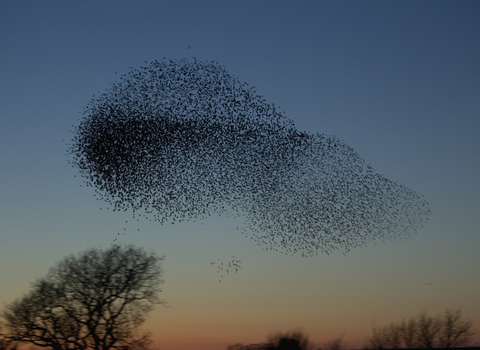Winter in the North is anything but barren; it is wild and busy with birds which travel to us annually to take advantage of our countries’ food resources.
Bird migration is one of nature’s marvels that has held the curiosities of scientists and birdwatchers for millennia. Why do they do it? How do they know when it is time to make the flight to find food and shelter in warmer climes?
It may seem like the perfect idea to go on a summer holiday from your home country to escape predators and the cold, but the journey some species undertake is immense and often deadly. Read on to explore which winter visitors we welcome each year, where we can appreciate them and how we can be gracious hosts to this array of amazing birdlife.
Winter Migration Guide – Migratory birds to spot this winter
Knots at Heysham, by Janet Packham
Why do birds migrate?
Birds travel to other countries to find food, breed and spend time in warmer temperatures. Britain is full of winter berries and plenty of insects to feed on, which makes it a great destination for birds such as redwings and fieldfares to journey to. Birds migrate for survival, but the journey itself can be long and treacherous, meeting with many risks along the way.
Risks include:
- Weather events - Travelling birds are susceptible to extreme weather, from storms to wildfires, they must navigate it all on their flyway to get to their destination. When they do arrive, if the weather conditions are extreme or unexpected, then this puts their need to feed after the long flight at risk too
- Fledglings can lose their flock - Another symptom of adverse weather is that younger birds can lose their way, especially on their first journey
- Predation- Despite migrating en masse and being naturally agile, journeying birds are still prey to eagle-eyed predators who take the opportunity to pick off part of the migrating flock.
- Humans- Unfortunately, it is not just predatory animals which target migratory birds. Humans also legally and illegally trap and hunt these winter warriors on their flight.
- Man-made obstacles - Migrant birds are intelligent and intuitive when it comes to navigating their trip; using the Earth's natural landscape, magnetic field, ingrained routes from previous years and even the skies to find their way. However, things like power lines, skyscrapers, wind turbines and other tall constructions quickly thwart and kill some of these birds, especially if the obstacle has been newly established since their last migration season.
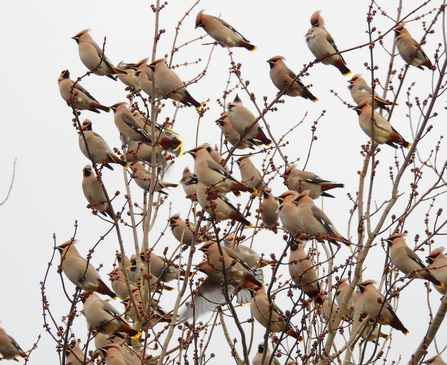
A flock of waxwings taking a holiday in Skipton. Photo by Jen Coates.
When does migration happen?
Birds leave the UK in autumn as the weather gets colder and the days get shorter, returning to us once again in the spring. Winter visitors flock to the UK in their place during autumn. Hormones released from glands in the body let a bird know when it is time to make the journey, along with these environmental changes. It really is a clever process, ingrained in these brave birds for life.
How do migrating birds know where to go?
Birds have evolved this migratory behaviour over millions of years. Glands which release hormones signal to them when it is time to move on to warmer temperatures in search of food and mates.
In flight, they use various things to navigate their flyway route, including mountain ranges, coastlines and rivers. However, they also look to the sun and stars to help them find their way, along with their sense of smell, and even the Earth’s magnetic field! Some young birds simply follow the lead of others who are familiar with the migration route, thereby learning the behaviour from their parents and elders. Once a bird has completed one annual migration cycle, this instinct is then ingrained in them for the rest of their life.
This short video represents the flyway routes of our wintering water birds
Which birds migrate to the UK during winter?
Fieldfare (Turdus pilaris) A sociable bird, fieldfares have a rich chestnut brown back, and a yellow breast streaked with black. They usually gather in grassland, farmland, and woodland habitats, in addition to our towns and gardens. A distinctively large and colourful thrush to admire this winter!
Conservation status: Red
Redwing (Turdus iliacus) A small number of redwings do breed in the UK, but most of the population fly from Scandanavia and Iceland.
Conservation status: Red
Waxwing (Bombycilla garrulous) - Waxwings are a much loved phenomena in the UK. They migrate from Northern Europe for a short time and can appear anywhere from town centres, carparks, back gardens. They arrive in 'irruptions' when resources in Northern Europe are scarce.
Conservation status: Green
Lapwing - Just like starlings, lapwings are 'partial migrants' meaning that some species migrate, and some stay in the country they nested in.
Conservation status: Red
Brambling - Brambling breed and nest in the forests of northern Europe and Asia in the summer before flying to the UK and central Europe for the cold months.
Conservation status: Green
Snowbunting - Snow buntings breed in the Arctic (from Scandinavia to Canada), and winter in the UK, mainly around the coast.
Conservation status: Amber
Merlin - Merlins are regularly spotted each winter at our Little Woolden Moss reserve. Resident merlins are joined by breeding birds from Iceland over winter.
Conservation status: Red
Short-eared owl - Some short-eared owls migrate from Scandinavia, Russia and Iceland for the winter.
Conservation status: Amber
Whooper swan - These migrants nest and breed in Iceland, but travel to the UK to winter.
Conservation status: Amber
Which species can I spot in our region?
Winter in the North is wild, and we are so lucky to be graced by these birds who journey to our island each year. On estuaries and riverways, hordes of waders and wildfowl cluster together for warmth, safety in numbers and a good feast. In Lancashire alone, you can spot:
Bewick's swan - The smallest UK swan, Bewick's swans are well travelled and fly to us all the way from Siberia.
Conservation status: Red
Bar-tailed Godwits - Breeding in Arctic Scandinavia and Siberia, they migrate in their thousands to spend winter with us on our coasts and wetlands
Conservation status: Red
Knots – Flocking in huge numbers to our estuaries, knots migrate all the way from the Arctic where they breed
Conservation status: Amber
Teals - Our smallest duck, teals are migrants from the cold climes of the Baltic and Siberia. In summer, teal breed in small numbers in the UK mostly in the north.
Conservation status: Amber
Curlews - Curlews reach their population high point in January, so now is the time to keep an eye out for them in their largest numbers on your next wetlands or estuary walk.
Conservation status: Red
Explore more about the true northern grit these resilient birds must have to get here each year.
Which places are best for winter birdwatching?
Our reserves are renowned for being great birdwatching spots. Bring your binoculars, warmest coat and a hot drink along to watch these amazing species socialise, scramble for food and soar through the skies.
The nature reserves we recommend for bird watching are:
- Brockholes nature reserve - Valuable habitats for winter migrators are wetlands, grassland and woodland. You can hope to see lapwings, bramblings and ringed plovers here.
- Middleton nature reserve - Grasslands and wetlands offer habitats and feeding grounds for wading birds, lapwings and the short-eared owl
- Heysham Nature reserve - With it's wetlands habitat, you are most likely to see waders and estuary birds here, however there is woodland which offers sanctuary for
- Seaforth - A must-visit for fans of wader birds. You can expect to see teals and curlews mingling with our resident UK birds like the ringed plover
- Lunt Meadows - One of our favoured reserves for birdwatchers, you can hope to see wader birds such as the whooper and Bewick's swan, teals, and short-eared owls
“Winter at Seaforth is a bird lover's dream; the lagoons and reedbeed host good numbers of teal, pochard, tufted duck, goldeneye and the incredibly rare scaup. Waders also abound– redshank, oystercatcher, ringed plover, dunlin and curlew are just a few of the 38 wader species recorded at this incredibly special nature reserve, living alongside white wagtails, yellow wagtails, meadow pipits and whinchats.”
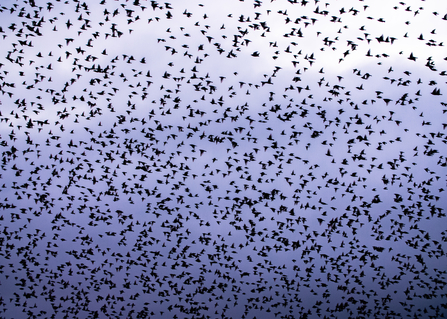
A rare capture of starlings up close
Photo by Alex Critchley
Partial Migrants - Stunning starlings
One of the best spectacles of nature to witness is a starling murmuration; starlings are partial migrants which means that their patterns depend heavily on the weather and seasonal temperatures. Most starlings that breed in the UK also stay with us over the winter period, however they are joined by starlings who travel from as far as Scandinavia, the Baltic States, the Low Countries, Germany, Poland and Russia, swelling the population up into staggering numbers! Over half a million starlings have been recorded as roosting together in one place by the middle of winter.
Breath-taking displays over Brockholes nature reserve have captured national attention, inspiring people to make an occasion of this daily spectacle.
Find out Where to see starling murmurations in Lancashire
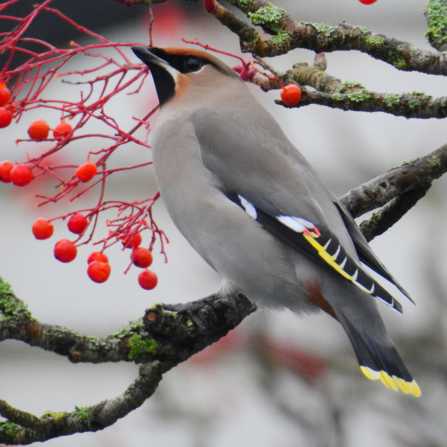
A wonderful waxwing feeding on winter berries in Burnley town centre
Photo by Jen Coates
How can I help our migrant visitors?
With the Red list of endangered or declining birds in the UK getting longer, our gardens, parks and community green spaces are increasingly becoming a safe-haven as a substitute habitat for our winged friends. There are things you can do in the winter, as all year round, which can provide safe shelter, much needed food and a life line for migrating birds.
-
Birdbath – Having a bird bath in your garden as rudimentary as a dish, old plate or hollow in the ground lined with foil is the number one most effective way to attract birds to your garden, offering them a drink and a bathe. In frosty weather, be sure to check that it has not frozen over, and keep it topped up.
-
Leave it be – The keen bird-gardener knows to always have a wild area, no matter how big or small. This means leaving a section off grass unmown, allowing autumn leaves to lie where they fell (this also prevents the ground from drying up over cold months)
-
Now you see me, now you don’t- Areas around bird feeders and bird baths should be clear of tall grasses or vegetation to allow birds to spot and escape predators like cats creeping up on their watering hole. Having said that, leaving sections of your garden wild, and wall climbing plants like ivy, vines, honeysuckle, and Clematis untrimmed offer birds shelter, protection from predators, a source of insect food, and nesting opportunities
-
Compost – a curious bird will always investigate a compost heap and be grateful for it!
-
Housing shortage - You can also help birds with somewhere to rest and warm up by building or buying a nestbox. Unfortunately, there are plastic nest boxes available to buy. Avoid these, as not only is the production and disposal of plastic a blight on the environment, but they also overheat during the summer, harming birds and forcing them to re-home themselves.
For more tips and advice on how to wild your garden this winter, read our blog here!
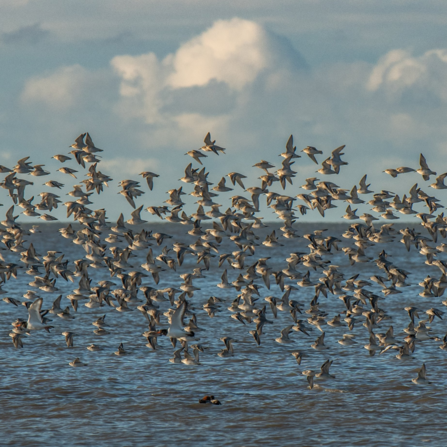
Knots on the move above the sea at Heysham
Photo by Janet Packham
Have you spotted any of our winter visitors? Share your sightings with us on social media!
Instagram @lancashirewildlifetrust
X (formerly Twitter) @Lancswildlife
Facebook @lancashirewildlifetrust
You can also contribute your sightings to a citizen science project with The British Trust for Ornithology called Bird track - helping to map the arrival and departure times of migrating birds, with location information!
More facts on bird migration behaviours can be found from our friends at RSPB and the Woodland Trust
















